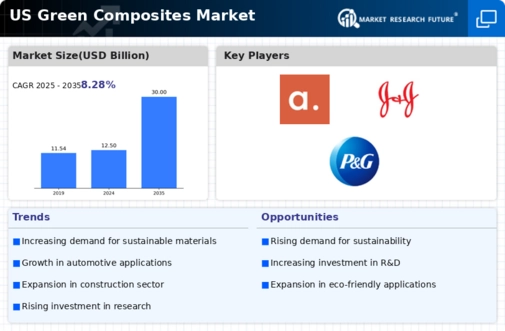Rising Energy Costs
The escalating costs of traditional energy sources are prompting industries to seek alternative materials that offer both cost-effectiveness and sustainability. Green composites, often derived from renewable resources, present a viable solution to mitigate energy expenses. As energy prices continue to rise, manufacturers are increasingly turning to green composites to enhance energy efficiency in their products. This shift is particularly evident in sectors such as construction and automotive, where the integration of green composites can lead to substantial energy savings. Consequently, the green composites market is likely to experience robust growth, with projections indicating a potential market size of $12 billion by 2028, driven by the need for cost-effective and sustainable solutions.
Government Incentives and Support
Government initiatives aimed at promoting sustainable practices are significantly influencing the green composites market. Various federal and state programs offer financial incentives for companies that adopt eco-friendly materials and technologies. For instance, tax credits and grants are available for research and development in sustainable materials, which encourages innovation within the green composites market. Additionally, regulatory frameworks are increasingly favoring the use of bio-based materials, further driving market growth. As a result, the green composites market is expected to benefit from these supportive measures, potentially leading to a market valuation of over $15 billion by 2030, as companies align their strategies with governmental sustainability goals.
Increasing Environmental Awareness
The growing consciousness regarding environmental sustainability is a pivotal driver for the green composites market. Consumers and industries alike are increasingly prioritizing eco-friendly materials, leading to a surge in demand for products that minimize ecological footprints. This trend is particularly pronounced in sectors such as automotive and construction, where the adoption of green composites can significantly reduce greenhouse gas emissions. In fact, the market for green composites is projected to reach approximately $10 billion by 2027, reflecting a compound annual growth rate (CAGR) of around 12%. This heightened awareness is not only influencing consumer choices but also prompting manufacturers to innovate and invest in sustainable practices, thereby shaping the green composites market in the US.
Consumer Preference for Sustainable Products
The shift in consumer preferences towards sustainable products is a significant driver for the green composites market. As awareness of environmental issues grows, consumers are actively seeking products that align with their values of sustainability and eco-friendliness. This trend is particularly evident in the packaging, automotive, and construction sectors, where consumers are willing to pay a premium for products made from green composites. Market Research Future indicates that nearly 70% of consumers in the US express a preference for brands that demonstrate a commitment to sustainability. This consumer behavior is compelling manufacturers to incorporate green composites into their offerings, thereby propelling the growth of the green composites market.
Technological Innovations in Material Science
Advancements in material science are playing a crucial role in the evolution of the green composites market. Innovations such as improved processing techniques and the development of new bio-based resins are enhancing the performance and applicability of green composites. These technological breakthroughs enable manufacturers to produce composites that not only meet but exceed the performance characteristics of traditional materials. As a result, industries are increasingly adopting green composites for applications that require high strength and durability. The green composites market is thus poised for growth, with estimates suggesting a market expansion to approximately $14 billion by 2029, as technological advancements continue to drive product development and market adoption.
















